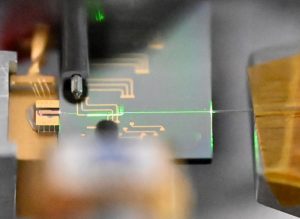November 13, 2023, reading time: 4 minutes.
High performance despite the mini format: For intensive, ultra-short laser pulses, a table-sized laser apparatus will soon no longer be necessary – it can also be done in chip format. Physicists have succeeded in shrinking these powerful phase-coupled lasers down to chip size. Although it fits on a fingertip, their prototype of this mini laser can already generate ultra-short laser pulses of up to 0.5 watts. In the future, femtosecond lasers with a pulse strength of just over one watt should also be possible, according to the team in “Nature Photonics”.
Lasers have long been indispensable in everyday life and research – this applies especially to pulse lasers, which generate ultra-short, coherent beam pulses in the femto and attosecond range. They can be used to visualize the fastest processes, such as the course of chemical reactions, the movement of electrons in materials or of messenger substances in a cell. Such pulse lasers are also used in photonics, quantum computers and quantum physics.
However, these lasers have so far been expensive, large and require a lot of energy. Physicists have already created chips with micro-color lasers, green nanolasers and photon sources in quantum chips. However, these either cannot generate ultra-short pulses or are not powerful enough for many common applications.
Phase locking is the key
The problem: In order to achieve high intensity of laser pulses despite their short duration, a special procedure is necessary. With this mode or phase coupling, the standing light waves generated in the laser medium, the so-called modes, are combined with one another in such a way that the wave crests reinforce each other at certain time intervals. This creates a sequence of ultra-short, regular and intense laser pulses.
“Our goal is to revolutionize the field of ultrafast photonics by converting large laboratory-based laser systems into just chip-sized ones,” says lead author Qiushi Guo from the California Institute of Technology. This would make mass production easier and make pulse lasers cheaper and more versatile. “But to do this, we have to ensure that these ultra-fast, chip-sized pulse lasers also provide sufficient power: for a chip laser to be useful, we need pulse peak intensities of preferably more than one watt,” Guo continues.
High pulse power despite miniature format
Guo and his team have now developed a phase-coupled pulse laser for the first time that comes very close to this goal: their laser prototype is only 1.5 millimeters in size, integrated into a microchip and can produce laser pulses with a duration of almost five picoseconds and a peak energy of 0 Generate .5 watts. “Our integrated phase-coupled laser offers the highest energy intensity and the highest peak pulse power of all previous pulse lasers on nanophotonic platforms,” says the team.

The new micro-pulse laser consists of two main components. The first is the laser medium made of gallium arsenide, a semiconductor material often used in semiconductor lasers and light-emitting diodes. The second component is connected to this laser emitter – the part in which phase coupling and amplification takes place. It consists of a silicon base with a thin layer of lithium niobate (LiNbO3). This nonlinear photonic crystal contains an electro-optical phase modulator and a loop-shaped waveguide that acts as a mirror.
By applying an electric field in the radio frequency range, the laser light in this phase modulator can be specifically manipulated and bundled into powerful pulses, as the team explains.
New possibilities for photonic applications
The result is a chip-sized laser that produces ultra-short, high-power infrared laser pulses. “In addition to its compact size, our laser also shows a number of other promising properties,” explains Guo. “For example, we can freely adjust the repetition frequency of the pulses over a wide range.” The distance between the ultra-short laser pulses can thus be specifically adapted to the respective application.
According to the physicists, their laser technology opens up new possibilities for the miniaturization of photonic applications. “By putting a powerful phase-locked laser on a nanophotonic chip and connecting it to other components, we can bring such laser applications from meter scale to chip size,” says Guo’s colleague Alireza Marandi. For example, experiments with attosecond lasers, which have just been awarded the Nobel Prize in Physics, could become smaller and cheaper in the future.
But other applications could also benefit from phase-coupled lasers on a chip scale: “In the future, this could enable chip-sized atomic clocks or the use of smartphones for the analysis of food and environmental factors, the detection of bacteria and viruses or even the diagnosis of eye diseases,” Guo says. (Science, 2023; doi: 10.1126/science.adj5438)
Source: California Institute of Technology, Advanced Science Research Center, GC/CUNY
November 13, 2023 – Nadja Podbregar

